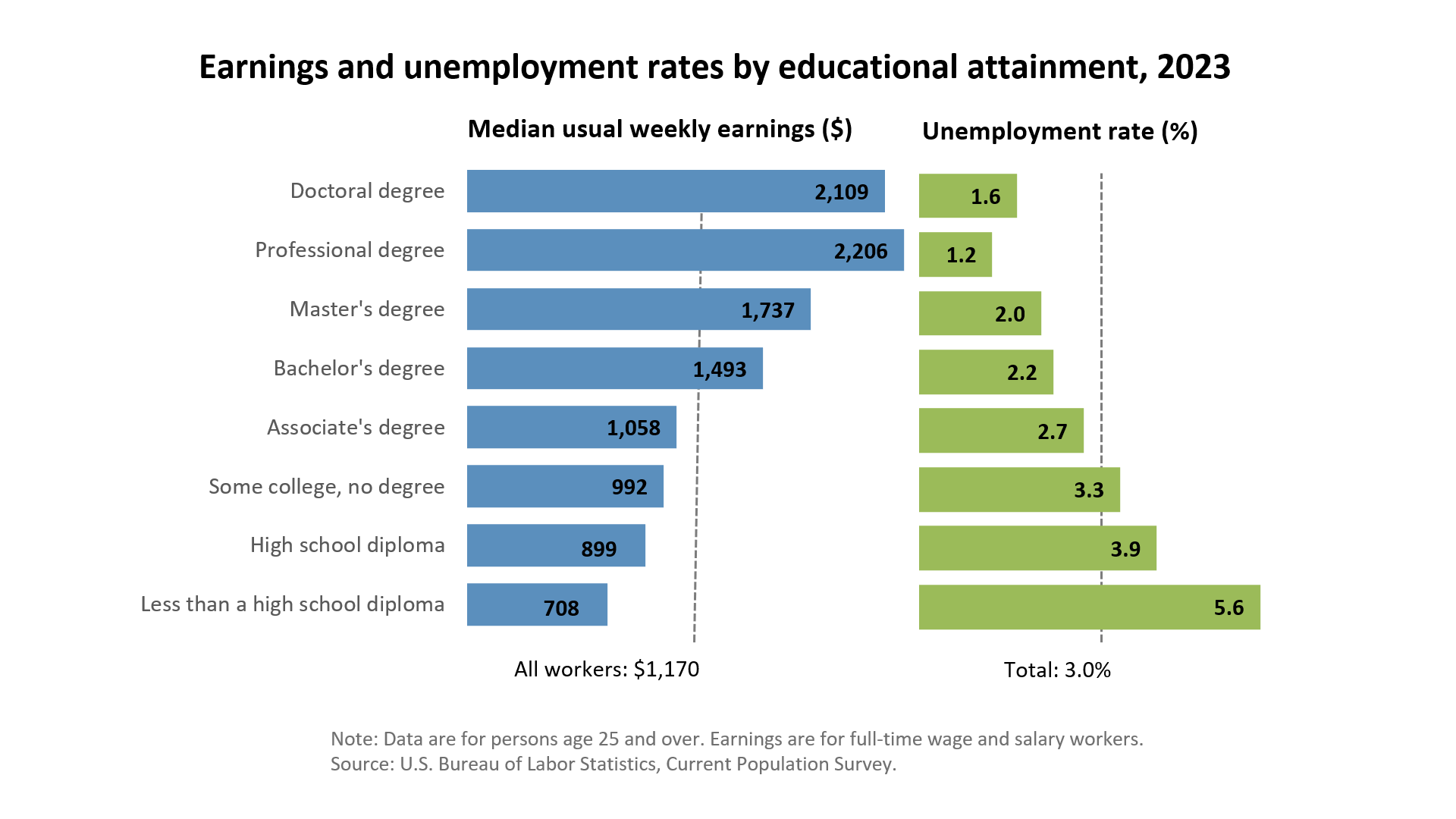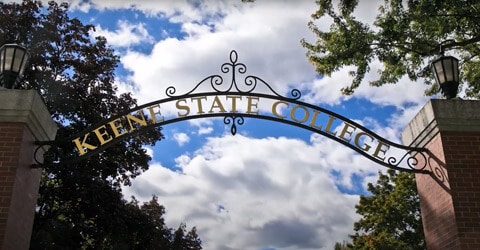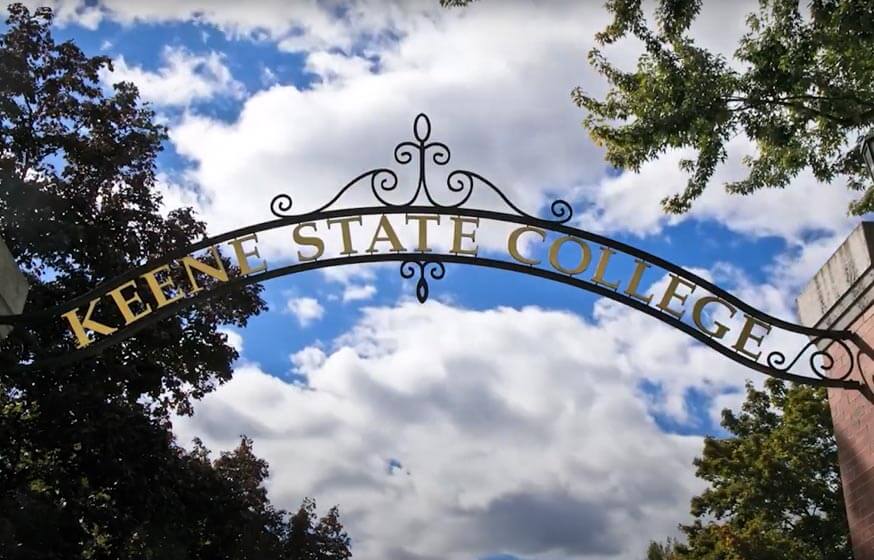Get Matched With Online Colleges
Keene State College is based in Keene, New Hampshire and is part of the University System of New Hampshire. The school enrollment is around 3,500; according to the US Census, the town itself is home to 23,400 people, so the college is a major part of the population when students are on campus.
Search All Programs
Overview of Keene State College
First established in 1909 as a teacher college, Keene is now a public liberal arts college offering over 40 areas of study. True to its roots, the education program remains one of the top degrees at Keene State College, as is the safety & occupational health, applied sciences program.
Keene State College offers a wide range of student services such as 24-hour security and emergency telephones, late night transportation and escort service, and secured buildings. They also offer health and counseling services, student tutoring, and specific departments for veterans and disabled students to help them acclimate to campus life.
General Information
| School Type | Public |
|---|---|
| Campus Setting | Town: Distant |
| Campus Housing | Yes |
| Student Faculty Ratio | 14:1 |
| Graduation Rate | 63% |
| Year Founded | 1909 |

Student Enrollment
Total Students3,543
3,477
66
Undergraduate Student
Male 1,565
Female 1,912
Graduate Student
Male 30
Female 36
Explore Map
Top Rankings For Keene State College
Admissions
APPLICATIONS4,978
ACCEPTANCE4,381
Acceptance Rate88%
Enrollment 832
| Admissions | |
|---|---|
| Application Fee | $50 |
| High School GPA | Required |
| High School Rank | Considered But Not Required |
| High School Transcripts | Required |
| College Prep Courses | Recommended |
| Recommendations | Required |
| SAT/ACT | Considered But Not Required |
| TOEFL (Test of English as a Foreign Language) | Considered But Not Required |
| Application Deadline | April 1 |
| Common Application Accepted | Yes |
Tuition Cost & Financial Aid
It’s important you don’t eliminate a school just because the cost of attendance seems insurmountable. Take a close look at the financial aid page of the school website and use tools such as College Navigator to estimate your out of pocket expenses. The net price of your education means the original cost minus funds from other sources such as grants and scholarships, so it may not be as expensive as it first appears.
You should complete the Free Application for Federal Student Aid (FAFSA) as soon as possible, as this will give you a good idea where you stand financially. The FAFSA is also required for most scholarship and grant applications as well as applications for federal educational loans.
| Average net price | 2018-2019 |
|---|---|
| Net Price | $19,805 |
| Average Total Aid | $8,395 |
| Students Receiving Financial Aid | 97% |
| Room & Board | $12,846 |
Sticker Price
- Tuition In-State - $14,568
- Tuition Out-of-State - $23,756
- Books and Supplies - $900
- Room & Board - $12,846
- Other - $1,500
Academics
While you may be focused on whether a college offers the academic courses you need, there are other aspects you should pay attention to as well.
Here are a few points you should look for when evaluating each school, and a brief explanation of why each is important:
- Retention Rate: The retention rate is the percentage of freshmen who return for their second year of study. A lower rate may indicate lack of support or a high number of dissatisfied students.
- Graduation Rate: A low graduate rate can be a red flag indicating one or more aspects of the college doesn’t support overall student success.
- Student-to-Faculty Ratio: This ratio will give you an idea of how personalized your classes will be and whether you’ll have quality interaction with your professors.
- Student Population Total: The total population is likely tied to the type of environment you wish to study in, but lower populations may also indicate a concentration on graduate program success.
- Distance Learning: Even if you plan to attend in person, you should make sure distance learning is an option, as evidenced by the disruption of campus classes during the pandemic.
- Accreditation: Accreditation is vital in many ways as it indicates the overall consistent quality of a school or program and is required for many forms of financial assistance.
Retention
Rate
4 year
Graduation
Rate
6 year
Graduation
Rate
Student Population Total
Student Population 3,543
3,477
66
Most Popular Programs & Majors
(# of Diplomas Awarded by Subject)
| All Education Majors | 111 Total Graduates / 14% |
|---|---|
| Elementary Education and Teaching | 50 Graduates |
| Early Childhood Education and Teaching | 19 Graduates |
| Mathematics Teacher Education | 16 Graduates |
| Secondary Education and Teaching | 12 Graduates |
| All Engineering Majors | 101 Total Graduates / 13% |
| Occupational Safety and Health Technology/Technician | 80 Graduates |
| Engineering Technologies and Engineering-Related Fields, Other | 21 Graduates |
| Health Professions and Related Programs | 85 Total Graduates / 11% |
| Health and Wellness, General | 38 Graduates |
| Dietetics/Dietitian | 17 Graduates |
| Registered Nursing/Registered Nurse | 16 Graduates |
| Athletic Training/Trainer | 9 Graduates |
| Visual and Performing Arts | 83 Total Graduates / 10% |
| Cinematography and Film/Video Production | 24 Graduates |
| Commercial and Advertising Art | 20 Graduates |
| Fine/Studio Arts, General | 17 Graduates |
| Acting | 6 Graduates |
| Music, General | 6 Graduates |
| All Business Majors | 57 Total Graduates / 7% |
| Business Administration and Management, General | 57 Graduates |
| All Other Diplomas | 56% |
Outcome & Salary
Graduates from Keene have an early career salary average of $49,900, with a mid-career salary of $83,600 and an overall average salary of $59,570. When you compare these amounts to the $38,792 national average salary for those with no college education you can easily see the advantage of completing your degree.
In terms of return on investment (ROI), which is the cost of education (investment) factored into your earning potential, you’ll see a 10 year projected ROI of $516,480 and a 20 year projected ROI of $1,431,70; again, compared to those with no college education who see a flat ROI of $387,920 in 10 years and $775,840 in 20 years, it makes it easy to see the financial advantage of completing your bachelor’s degree program.
Note that these figures don’t include the earnings of those who choose to continue their education to the master’s or doctoral level, who generally enjoy a higher salary range.
| Graduates Salary | |
|---|---|
| College Grads Early Career Salary | $48,900 |
| College Grads Average Salary | $59,570 |
| College Grads Mid Career Salary | $83,600 |
| Return on Investment (ROI) | |
|---|---|
| 10 Year Salary Earnings Potential | $595,700 |
| 20 Year Salary Earnings Potential | $1,431,700 |
| Cost of Education (Net Price) 4 Year | $79,220 |
| 10 Year Projected ROI | $516,480 |
| 20 Year Projected ROI | $1,352,480 |
| No College Education Salary Comparison | |
|---|---|
| National Average Salary | $38,792 |
| 10 Year Projected Income | $387,920 |
| 20 Year Projected Income | $775,840 |

Related Top College Resources






